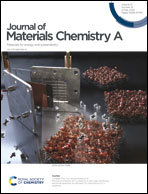Spatially separated catalytic sites supplied with the CdS–MoS2–In2O3 ternary dumbbell S-scheme heterojunction for enhanced photocatalytic hydrogen production†
Abstract
Inspired by natural photosynthesis, the development of high-efficiency and low-energy hydrogen production catalysts is essential to alleviate environmental problems. Here, the CdS nanorods are the main body, and the CdS–MoS2 dumbbell structure is synthesized by the solvothermal method to make the photogenerated electrons flow along the one-dimensional axis. The nanoconfinement effect of MOF-derived In2O3 hollow hexagonal prisms greatly expands the spectral absorption range of the composite photocatalysts. The CdS–In2O3 S-scheme heterojunction was constructed by a simple electrostatic-driven self-assembly method. In situ irradiation X-ray photoelectron spectroscopy analysis shows that the internal electric field drives the photogenerated electrons in In2O3 to move to CdS, forming a S-scheme heterojunction of CdS–In2O3, which greatly promotes the separation of electron–hole pairs. In2O3 is combined with the sidewalls of the CdS–MoS2 dumbbell to weaken the surface oxidation kinetics, thereby inhibiting the surface photo-corrosion reaction. MoS2 promotes the CdS–In2O3 S-scheme heterojunction photocatalyst to show significant photocatalytic hydrogen evolution performance. The hydrogen production rate under the irradiation of a 300 W simulated light source is 198.58 mmol h−1 g−1, and natural light can produce a large number of visible bubbles. The effective separation of reduction and oxidation functional sites in space, the directional transfer of photogenerated electrons–holes, and the construction of S-scheme heterojunctions are the main factors for the significant increase in the catalytic activity of semiconductor photocatalysts. This work provides an effective strategy for designing metal sulfide-based photocatalysts with high activity and high stability of water-splitting properties.



 Please wait while we load your content...
Please wait while we load your content...